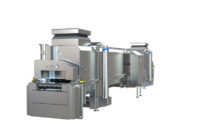GEA has the cure that will inject value into bacon

To overcome the challenges faced by food producers curing bacon products, leading technology provider GEA Food Solutions has developed an advanced injection technique which contributes to high brine retention and low standard deviation – crucial to ensuring consistency of distribution, quality and yields.
GEA’s Multijector, an automated injection system, introduces brine in a high-density injection pattern, combined with low injection pressure, avoiding injection points becoming saturated which can cause the brine to purge. A higher density of needles allows less brine per needle stitch to be injected at a lower pressure down to 1.2-1.5 bar.
Benefits for bacon producers using a high-density injection pattern include improved slicing yield, reduced post-injection purge and drip loss, optimum moisture and salt levels, while avoiding injecting air or foam, potentially extending the shelf life of ready-to-cook bacon by weeks. Reduced post-injection purge which avoids drip loss on the floor after combing, not only impacts yield savings, it also means significantly reduced cleaning costs.
GEA’s Product Manager for Marination Henrik Thrysoe, said: “Customers will not purchase bacon products which have inconsistent appearance, discoloration or a short shelf life. The distribution of brine must be even, consistent and well retained within the product. A tight needle pattern, in combination with vibration at a very specific frequency, closes the needle holes and ensures brine retention.”
Bacon which has been injected using this technique has a drier surface. If it is then liquid smoked by drenching or atomizing, less liquid smoke needs to be used, meaning further production cost savings. If the bacon is traditionally smoked, the first drying step can be reduced or potentially avoided, providing increased smokehouse capacity.
The quality of injection needles used also has an impact upon the efficiency of the process as well as the quality of the end product. Bent needles lead to under-injected and over-injected areas in the final product, which causes inconsistent product quality, short shelf life, and can cause a tiger stripe pattern. GEA OptiFlex needles are stronger than traditional stainless steel and have the superior property of recovering their shape time and time again instead of becoming deformed or bent.
Time-in-Meat is a GEA injection precision technique based on the specific combination of stroke height and injection cycle time, both optimised for each product type. Thanks to the Time-in-Meat technique, the needles stay in the product longer during injection, which leads to better brine uptake and more even brine distribution at a low injection pressure. As a result, product quality and consistency are significantly increased, and higher efficiency and yields can be achieved.
The meat sector can benefit by taking greater control of brine injection by understanding the process and the quality of the equipment deployed. Doing this will ensure the benefits extend from the processor to the reseller and ultimately to the all-important end consumer.
For more information visit www.gea.com.
Looking for a reprint of this article?
From high-res PDFs to custom plaques, order your copy today!





